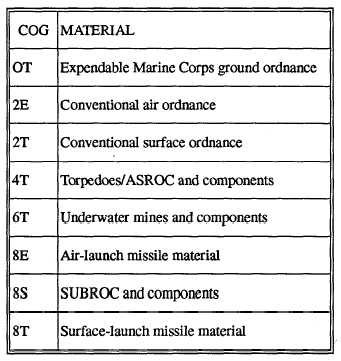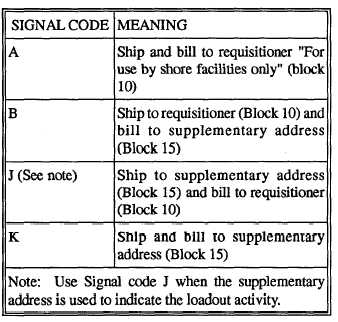3. Card columns 36 through 39 (date). Enter the
four digits that represent the Julian date on which the
requisition is transmitted to the supply source. The
Julian date consists of two elements-the last digit of
the calendar year and the numeric consecutive day of
the calendar year. For example, 8181 represents 30 June
1988. The numeric consecutive days of the year can be
found on government-issue calendar pads.
4. Card columns 40 through 43 (serial). Enter a
four-position serial number. Automated ships should
use 5000 (series) serial numbers; nonautomated ships
should use 8000 (series) serial numbers. Never duplicate
the same serial number on the same Julian date.
CARD COLUMN 44 (DEMAND). The demand
code shows whether the demand is recurring or
nonrecurring. Use demand code R (recurring) when the
item requisitioned is for shipfill, mission load, cargo
load, or ABSLA allowance. Use N (nonrecurring) when
the item requisitioned is clearly a onetime request.
C A R D C O L U M N S 4 5 T H R O U G H 50
(SUPPLEMENTARY ADDRESS). The supple-
mentary address field is a mandatory entry and a
multiuse field. Fleet units use this field to indicate
where the requisitioned material is to be received and
loaded by entering the service code and UIC of the
loading activity. Shore activities use this block for local
information (such as storage location) by first entering
the letter Y in block 14.
CARD COLUMN 51 (SIGNAL). The signal code
identifies the activity to which the material is shipped
Table 17-2.—Signal Codes
and/or billed. Table 17-2 provides a list of signal
codes and their meaning. Enter the appropriate signal
code.
CARD COLUMNS 52 THROUGH 53 (FUND).
The Fund code is a two-character code that cites
accounting data on Navy requisitions. Fleet units
should enter Fund code Y6 and shore activities should
enter Fund code 26.
C A R D C O L U M N S 5 4 T H R O U G H 5 6
(DISTRIBUTION). Distribution field entries serve a
dual purpose and are mandatory entries. The first
position indicates the monitoring activity, and the other
two positions indicate the cognizance symbol of the
material being ordered. CINCLANTFLT is the
monitoring activity for all ammunition requisitions.
Fleet units enter code R and shore activities enter code
8 in card column 54. With this code, CINCLANTFLT
receives 100-percent supply and shipment status on the
requisition. In card columns 55 and 56, enter the
applicable cognizance symbol of the material being
ordered. Table 17-3 lists the material and COG
symbols.
C A R D C O L U M N S 5 7 T H R O U G H 59
(PROJECT). The Project code is a mandatory entry for
identifying the purpose of the requisitioned item. There
are several Project codes for requisitioning ammunition.
They are all within the 800 series. A few of the more
Table 17-3.—Cognizance Symbols
17-10





